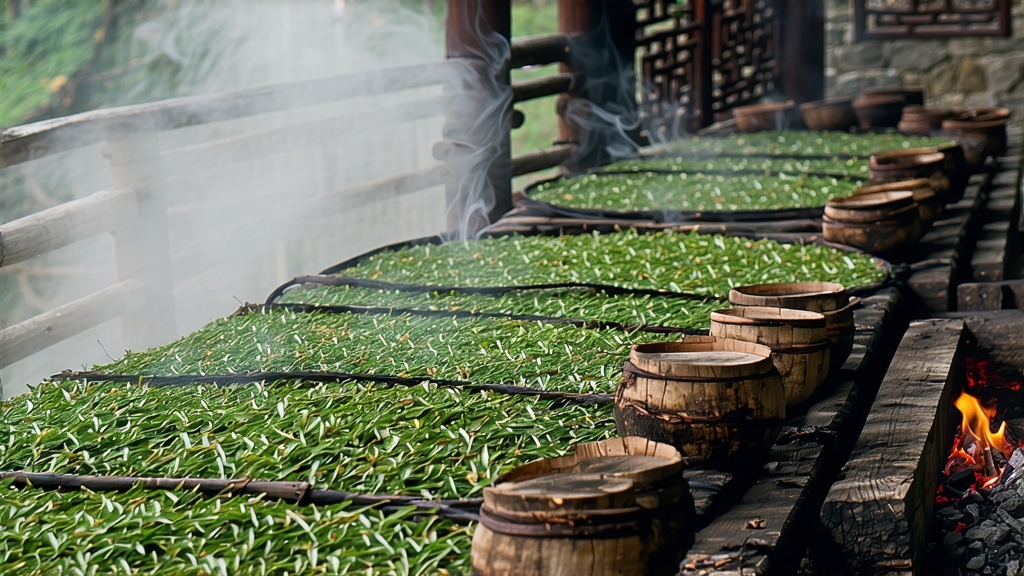
When European tea clippers first rounded the Cape of Good Hope in the mid-seventeenth century, the chests that most excited London’s coffee-house keepers were stamped with a single, exotic word: Bohea. Inside those lead-lined crates lay slender, pitch-black twists of leaf that, once infused, exuded a perfume unknown in the West—smoky, wine-like, almost incense-sweet. That leaf was Lapsang Souchong, the original black tea of the Wuyi Mountains in China’s Fujian province and, by most accounts, the progenitor of every red-black tea that followed. Today, while Keemun, Assam and Ceylon have become household names, Lapsang Souchong remains a cult classic: a tea that carries within its curled leaves the dual signature of Chinese terroir and human ingenuity, a flavour that can transport the drinker from a modern kitchen to a cedar-clad workshop high in mist-laden cliffs with a single sip.
History: from Ming-dynasty accident to global sensation
Local lore places the birth of Lapsang Souchong around 1567–1610, late in China’s Ming dynasty. Wuyi tea farmers, obliged to deliver their spring pick to passing armies, found the leaves left behind oxidising far beyond the familiar green-tea stage. Rather than discard the crop, they speed-dried it over available pine fires so it would survive the long trek to market. The result—deeply oxidised, heavily scented—was an instant hit with the Dutch, who carried it to Europe and ignited a fashion for “black” tea that would soon eclipse green in British cups. By the 1662 wedding of Catherine of Braganza to Charles II, Lapsang Souchong was already a luxury item at court; Samuel Pepys mentions “a cup of Bohea” in his 1667 diary as a mark of status. Two centuries later, when Scottish planters smuggled Chinese tea seeds and craftsmen into India, they used Lapsang Souchong as the flavour benchmark for the first Assam experiments, thereby bequeathing its DNA to the entire black-tea world.
Terroir: why Wuyi’s cliffs taste of smoke and stone
The Wuyi Mountains, a 60-kilometre chain of weathered granite and volcanic tuff, form a natural amphitheatre around the Chong’an River. Daytime temperatures can swing 15 °C within hours; night fogs roll in, feeding slow-growing tea bushes that cling to thin, mineral-rich soils. Two indigenous cultivars dominate the area: Xiao Zhong (small leaf) and Da Bai (big white). Their leaves are small, thick and heavily veined—ideal for withstanding the rigorous smoke-drying process. The pine species used for firing, mainly Masson and Huangshan pine, exude a resin high in α-pinene and longifolene, terpenes that bond with leaf polyphenols during drying and create the tea’s signature note of smoked apricot and camphor.
Craft: the eight stages that turn leaf into legend
- Plucking: only the standard “two leaves and a bud” are taken, between Qingming and Guyu (early April). Pickers start at dawn while dew still weighs the leaf, slowing oxidation.
- Withering: trays of leaves are laid on bamboo racks in shaded corridors where mountain breeze reduces moisture to 60 %. No sun-withering is used; the goal is suppleness, not grassiness.
- Rolling: once veins turn translucent, the leaves are rolled in 3-kg batches inside linen sacks, pressed by foot in a 400-year-old wooden trough. This ruptures cells and releases catechins without the heat generated by modern machines.
- Oxidation: the rolled leaf is heaped in pine-wood crates lined with wet cloth. Temperature is kept at 24–26 °C for 3–4 hours, turning every 30 minutes. The leaf edges turn copper, the centre remains olive—an optical signature known as “tiger skin”.
- Pan-firing: a quick 90-second tumble in a 200 °C wok halts oxidation, setting the colour and arresting vegetal notes.
- Smoke-drying: the decisive step. A brick-lined pit is filled with pine logs smouldering at 80–90 °C; a bamboo sieve stack sits 70 cm above.